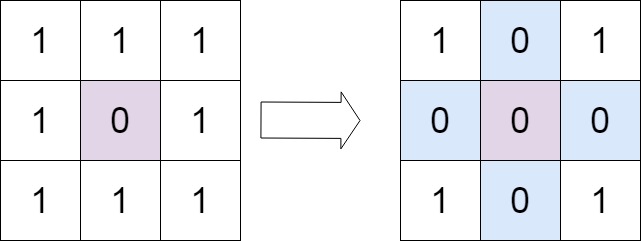LeetCode-in-All
73. Set Matrix Zeroes
Medium
Given an m x n integer matrix matrix, if an element is 0, set its entire row and column to 0’s.
You must do it in place.
Example 1:

Input: matrix = [[1,1,1],[1,0,1],[1,1,1]]
Output: [[1,0,1],[0,0,0],[1,0,1]]
Example 2:

Input: matrix = [[0,1,2,0],[3,4,5,2],[1,3,1,5]]
Output: [[0,0,0,0],[0,4,5,0],[0,3,1,0]]
Constraints:
m == matrix.lengthn == matrix[0].length1 <= m, n <= 200-231 <= matrix[i][j] <= 231 - 1
Follow up:
- A straightforward solution using
O(mn)space is probably a bad idea. - A simple improvement uses
O(m + n)space, but still not the best solution. - Could you devise a constant space solution?
Solution
#include <stdio.h>
#include <stdlib.h>
void setZeroRow(int **matrix, int cols, int row) {
for (int j = 0; j < cols; j++) {
matrix[row][j] = 0;
}
}
void setZeroCol(int **matrix, int rows, int col) {
for (int i = 0; i < rows; i++) {
matrix[i][col] = 0;
}
}
void setZeroes(int** matrix, int matrixSize, int* matrixColSize) {
int setFirstRow = 0, setFirstCol = 0;
// Step 1: Determine which rows and columns to zero out
for (int i = 0; i < matrixSize; i++) {
for (int j = 0; j < *matrixColSize; j++) {
if (matrix[i][j] == 0) {
matrix[i][0] = 0; // Mark the first column
matrix[0][j] = 0; // Mark the first row
if (i == 0) setFirstRow = 1; // Indicate first row needs to be zeroed
if (j == 0) setFirstCol = 1; // Indicate first column needs to be zeroed
}
}
}
// Step 2: Zero out cells based on marks in the first row and column
for (int i = matrixSize - 1; i > 0; i--) {
if (matrix[i][0] == 0) {
setZeroRow(matrix, *matrixColSize, i);
}
}
for (int j = *matrixColSize - 1; j > 0; j--) {
if (matrix[0][j] == 0) {
setZeroCol(matrix, matrixSize, j);
}
}
// Step 3: Zero out the first row and column if needed
if (setFirstRow) {
setZeroRow(matrix, *matrixColSize, 0);
}
if (setFirstCol) {
setZeroCol(matrix, matrixSize, 0);
}
}

